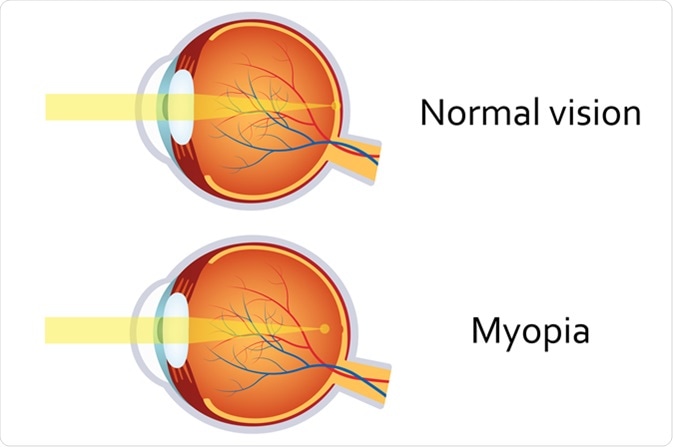A phakic intraocular lens (PIOL) is a synthetic lens that can be implanted into the eye to correct nearsightedness (myopia).

Myopia. Image Credit: Neokryuger / Shutterstock
What is a phakic intraocular lens?
Phakic intraocular lenses (PIOL), which are made up of synthetic materials such as plastic or silicon, can be surgically implanted in the anterior or posterior chamber of the eye. This type of lens enables light to focus accurately on the retina to correct and improve vision in myopic patients. During the surgery, a small incision is made on the front of the eye to insert and place the lens just in front of or behind the iris (the colored portion of the eye).
What is the purpose of using a PIOL?
A PIOL is used to correct the focusing power of the eye (as seen in refractive errors). Inside the eye, light is focused on the retina by the cornea and natural lens, which is necessary for image formation. Any impairment in the eye’s focusing power ultimately results in the formation of a blurred (out of focus) image on the retina. A PIOL works by correcting this error so that a clear image can be produced on the retina without the need for glasses or contact lens.
PIOL is mostly used as an alternative to other refractive error correction surgeries, such as photorefractive keratectomy (PRK) and laser assisted in-situ keratomileusis (LASIK). People who are extremely nearsighted, or have astigmatism (improper curvature of the cornea or natural lens), are particularly suitable candidates for PIOL. In addition, PIOL is suitable for people who are suffering from certain eye disorders, such keratoconus or dry eye syndrome.
To be eligible for PIOL implantation, the person should ideally be over 21 years old and should have had stable refraction for at least one year. The iridocorneal angle (the angle between the cornea and iris) should be more than 30° and a mesopic pupil size less than 5-6 mm in ideal candidates.
People with anterior segment disease, chronic uveitis, retinal problems, or macular degeneration are not suitable for PIOL implantation. A previous history of ocular surgery, cataract, or glaucoma also makes a person less suitable for PIOL surgery.
Phakic Intraocular Lenses - Assil Eye Institute Los Angeles
How is the PIOL implanted?
The PIOL implantation is performed under sterile precautions with local anesthesia to the eye delivered by eye drops. During the surgery, the eye lids are kept open using a lid speculum. A tiny incision of 3 – 6 mm is then made over the front of the eye. Next, the PIOL is inserted through the incision and placed appropriately, with the help of a gel-like material used to fill the space in the front of the eye.
After the implantation, the gel-like material is removed and replaced with fluids and antibiotics. In most cases, the incision is then closed using dissolvable stitches.
What are the benefits of using a PIOL?
A PIOL provides high quality vision and significantly improves the visual acuity in people with myopia. It is associated with higher patient satisfaction. Compared to laser surgery, PIOL implantation is safer and can reduce the risk of corneal ectasia and retinal detachment.
What are the risk factors?
PIOL implantation procedure is associated with the risk of inflammation, infection, and bleeding. The surgery often causes an increase in the intraocular pressure, which is a significant risk factor for the onset of glaucoma. Another complication is surgery-induced endothelial cell damage, which may eventually result in corneal decompensation. In addition, a chronic eye inflammation can increase the risk of cataract formation.
Further Reading